Advice from the International Association of Pediatric Dentists for children ages 2-5
Commonly Asked Questions
- By two years of age, are all the baby teeth present?
- What type of toothbrush do you recommend?
- How often do you recommend cleaning teeth?
- How much toothpaste is it safe to use on my toddler?
- What can be done if my child doesn’t like toothpaste?
- Why do my child’s upper and lower teeth not come together?
- What do you suggest to get my child to stop sucking the thumb?
- What is the black stain on my child’s teeth?
- Should children’s first teeth be flossed?
- Is it O.K. that my family does not drink tap water?
- Is it necessary to take fluoride tablets for “strong teeth”?
- Does my child need a fluoride application at the dentist?
- Does my child need x-rays?
- Why are primary teeth filled?
- I am worried about my child’s visit to get teeth fixed, is there anything I can do to help?
- Why do the gums around my child’s upper teeth bleed when brushing?
- Does it matter that my child had a primary tooth removed?
- If my dentist recommends fillings, should they be white or silver?
- What is a space maintainer?
Some Answers
-
By two years of age, are all the baby teeth present?
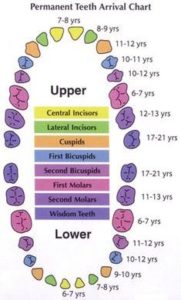
There is a lot of variation among children. The likely answer is no! Primary teeth begin to arrive around 6 months of age. By age two, 16 teeth usually are present and the last of the molars begin to appear, but they do not finish erupting until around 30 months. The upper molars are usually the last to come in.
-
What type of toothbrush do you recommend?
There are many types of toothbrushes on the market. Some manufacturers specialize in the development of children’s toothbrushes.
Rather offering a brand name, we would like you to think about what you want in a toothbrush for a child 2 -5 years old. Look for a brush with a short and bulky handle as this is easier for the young child to manage. Bristles should be soft to avoid injury.
-
How often do you recommend cleaning teeth?
One of the most important things about a tooth cleaning schedule is developing good habits. Brushing should be done at least twice daily – morning and at bedtime. Of course, if it is done more often it is beneficial, especially after meals or sweet snacks. The highest prevention against cavities, happens when brushing with fluoride toothpaste is supervised by parents.
-
How much toothpaste is it safe to use on my toddler?
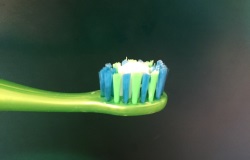
Toothpaste amount for Ages 0-2
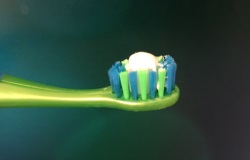
Toothpaste amount for ages 2-6
As mentioned before, children 0-3 should use an amount of fluoride toothpaste equal to the size of a grain of rice twice a day. Children 3 to 6 should use an amount equal to the size of a pea. This amount is safe even if swallowed, however, it is a good idea to teach your toddler to spit the excess toothpaste. Rinsing is NOT necessary, as the highest protection against cavities results from brushing and spitting only.
-
What can be done if my child doesn’t like toothpaste?
Brushing is important as it allows to remove the food debris from around the teeth and gums. However, toothpaste with 1000 ppm of fluoride makes the tooth more resistant to decay by making the outer tooth layer (enamel) stronger. Without fluoride toothpaste this benefit is lost. Toothpastes also help to have a pleasant breath. Different brands have different flavoring.
You may try several toothpastes so as to find the one your child likes. In this way you will help him/her to get used to the routine of brushing. Just make sure that you always use the right amount of toothpaste: size of a grain of rice for 0-3 and size of a pea for children 3 to 6.
-
Why do my child’s upper and lower teeth not come together?
This is typical of what dentists call an “open bite”. This situation can be seen in younger children (2-5 years) and in some older ones too. There are several reasons why this may occur. One of the most common causes of an open bite is habit. Sucking fingers or thumbs, placing the tongue between the teeth and holding objects between the teeth (like a pacifier) all are habits that can cause this problem. It can also be a family trait.
There are choices for dealing with open bites due to habits. The condition can be left without treatment. There are several ways that a habit can be eliminated. When this is done, very often the teeth move back into a better position without further treatment. Your dental caregiver should be consulted if your child has any of these habits.
-
What do you suggest to get my child to stop sucking the thumb?

Children between ages 2 to 5 years are usually developing the social skills that will allow them to slowly stop their sucking habit. Aggressive treatment is not recommended before this age. An occasional reminder to remove the finger is reasonable, always trying to be positive. Encourage and reward the child for not sucking, praising them for their grown-up behavior.
Parents sometimes want to tackle the habit problem too early. About half of the children who suck a digit, give the habit up spontaneously at about age three. Many of those who persist will drop the habit about age 6. Loose front teeth and peer pressure will cause many children at this age to give up the habit. If your child persists beyond the age of 6, consulting with your dentist will allow a closer evaluation and the possibility for stopping the habit by other means.
-
What is the black stain on my child’s teeth?
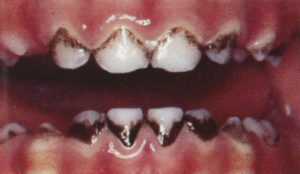 Black stain is a result of a combination of many things in the mouth related to saliva, bacteria and foods. Black stain on the surfaces of teeth is associated with very low decay rates. No one seems to understand this association and it has been a topic of research.
Black stain is a result of a combination of many things in the mouth related to saliva, bacteria and foods. Black stain on the surfaces of teeth is associated with very low decay rates. No one seems to understand this association and it has been a topic of research.
Other kinds of stains also appear on the outside of teeth. Green, orange and gray stains are the most common. These stains may indicate poor hygiene and under them early signs of tooth decay may be found.
Professional cleaning should remove the stain initially, and supervised periodic tooth-brushing helps control the staining.
-
Should children’s first teeth be flossed?
Dental flossing cleans between the teeth in areas that the toothbrush cannot reach. For some children, it is an important addition to the cleaning routine.
Primary teeth can have spaces between them, or be very close together. If spaced, they do not require flossing as the toothbrush can reach the areas between teeth. If they are not spaced, children’s teeth should be flossed. At this age children cannot be expected to floss themselves. Parents need to help them. We suggest that you speak to your dental health care giver -dentist, therapist or hygienist- for advice as to the need to floss.
-
Is it O.K. that my family does not drink tap water?
The question simply cannot be answered with a straight “yes or no”. For various reasons, people may prefer not to drink tap water. In communities where fluoride is naturally present in the water, or where it is added to it, it has been shown to reduce children’s dental decay by up to 50%. If you have this in your community, by not drinking tap water your family is not receiving this inexpensive and terrific preventive tool.
If you choose not to drink tap water, or if the water in your community does not contain fluoride, your dental professional can advise you if a fluoride supplement can be taken. Even better, brushing your children’s teeth twice a day with the appropriate amount of fluoride toothpaste since the eruption of the first tooth, will insure the fluoride is available surrounding the teeth, where it is most beneficial.
-
Is it necessary to take fluoride tablets for “strong teeth”?
Fluoride tablets should only be taken on recommendation or prescription from a health care provider.
Teeth exposed to fluoride are more resistant to tooth decay. If the water in your area does not contain fluoride, your dental provider should be able to evaluate your child’s risk to get cavities, to recommend the appropriate additional fluoride options.
-
Does my child need a fluoride application at the dentist?
A child’s risk of getting cavities is the main factor in this decision. During your dental appointment the dental
 team will evaluate the fluoride that your child gets through the water, the toothpaste and other sources. They will also evaluate your child’s diet, nutritional habits, and how well and frequently they floss. This information together with an examination of the child’s teeth, (their shape, closeness, and strength) as well as the gum’s condition will allow the dentist to determine if your child is at risk of getting cavities in the near future. Children who have had cavities recently are also at high risk of developing more cavities. If your child is at risk of having cavities for any of the reasons mentioned above, they will certainly benefit from the extra protection of a fluoride application during the dental appointment.
team will evaluate the fluoride that your child gets through the water, the toothpaste and other sources. They will also evaluate your child’s diet, nutritional habits, and how well and frequently they floss. This information together with an examination of the child’s teeth, (their shape, closeness, and strength) as well as the gum’s condition will allow the dentist to determine if your child is at risk of getting cavities in the near future. Children who have had cavities recently are also at high risk of developing more cavities. If your child is at risk of having cavities for any of the reasons mentioned above, they will certainly benefit from the extra protection of a fluoride application during the dental appointment.
-
Does my child need x-rays?
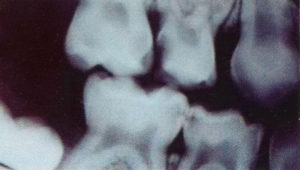 A child’s history of tooth decay or their risk of getting cavities are the main factors in this decision. If a child has had cavities recently, or if there are no spaces between the teeth to check them directly, the dentist may recommend x-rays as frequently as every 6 months.
A child’s history of tooth decay or their risk of getting cavities are the main factors in this decision. If a child has had cavities recently, or if there are no spaces between the teeth to check them directly, the dentist may recommend x-rays as frequently as every 6 months.
There are other factors that may influence the decision to take x-rays. If a child has had fillings in the past, the dentist may need to x-ray to follow-up on them. Family history may be an influence, especially if other children in the family have many cavities. Most dentists today take x-rays “based on individual need”, rather than routinely. That means they examine the mouth and the child’s history, before making the x-ray decision for the individual patient.
-
Why are primary teeth filled?
When primary teeth have cavities (decay), it is recommended that they are fixed with a filling. Fillings are placed in the teeth to repair them until they fall out normally. This prevents pain from food getting lodged in the cavity, prevents the cavity from getting larger, and allows the teeth to remain in the mouth until they fall out naturally. When teeth are not fixed, the cavity will get larger and larger until it reaches the nerve causing an infection that can produce an abscess or swelling in the face. Teeth left to decay can lead to unnecessary health problems.
If teeth are removed early, space may be lost in the dental arch. The end result is that the permanent teeth may become crowded in a mouth that might have had a good, straight set of teeth.
A third reason that baby teeth are filled is to reduce the bacteria (germs) in the mouth that cause tooth decay. These bacteria multiply in open cavities, were food debris is hard to clean. Eventually, the decay continues on other teeth and even on the permanent teeth when they come into the mouth.
-
I am worried about my child’s visit to get teeth fixed, is there anything I can do to help?
We would all like the dental visit to be a good experience. There is little point in saving the tooth and losing the child! Research tells us that anxious parents can pass their anxieties to their children. So, try to be relaxed and positive. Treat the visit as a routine part of life and health care. There are children’s books and web sites that can be used to explain procedures. These can be helpful. You may also ask friends and other family members about dental practices that are oriented toward children or about dentists who limit their practice to children. Other children in the dental office and a dental team who look forward to treating children can be a big help to the child.
-
Why do the gums around my child’s upper teeth bleed when brushing?
The most common cause for gums bleeding is gingivitis, meaning the infection and/or swelling of the gums. This happens when plaque is left for extended periods on the gums, due to poor or insufficient brushing. Some parents and children avoid brushing the gums because they bleed. This is a mistake because it makes the problem worse. Proper gentle brushing on the gums, will remove the plaque deposits and will stop the bleeding. However, it may take 7-10 days of regular, thorough brushing to see full improvement.
There are other possible reasons for gums bleeding when brushing. A cause may be dehydration or drying of the mouth, usually caused by mouth breathing. Mouth breathing happens when children have difficulty in breathing through the nose due to problems such as allergies, large adenoids or tonsils. Some children have a short upper lip and this prevents the lips closing at night. The mouth is meant to be moist. Bleeding gums are not healthy. Orthodontic correction may be needed to straighten the teeth so that the lips can close comfortably.
In rare occasions, bleeding gums could be related to medical conditions. Therefore, if there is no improvement in the gums after regular brushing, consult with your dentist.
-
Does it matter that my child had a primary tooth removed?
Yes, it may be a problem later on especially if back teeth are lost early. It usually is not a problem for the front teeth. Primary teeth are a specific size and occupy a certain amount of space in the jaw. If a primary tooth is removed early, the nearby teeth may drift into the space that has been created by the lost tooth. This means there will be insufficient space in the future for the permanent tooth that will replace the lost tooth. The end result is that the way the teeth bite together may be affected.
-
If my dentist recommends fillings, should they be white or silver?
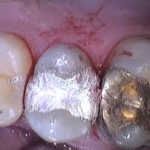
Repairing teeth is a difficult job. The type of filling depends upon many things such as the size and location of the cavity, the age of the child and above all, the ability of the child to cooperate for the procedures. Some dentists prefer one type of filling material over another and some of these factors will influence their decisions. Some dentists also use pre-made silver crowns. These are used when there is a lot of tooth damage. Talk to your clinician about the choices.
-
What is a space maintainer?
A space maintainer is an appliance that protects space in the jaw that is created when a tooth is lost prematurely. There are two general types of space maintainers. Fixed space maintainers are held to the teeth by a dental cement. Removable space maintainers can be taken out and cleaned. The design of a space maintainer depends upon the teeth missing, the teeth present and the child’s tooth development.
